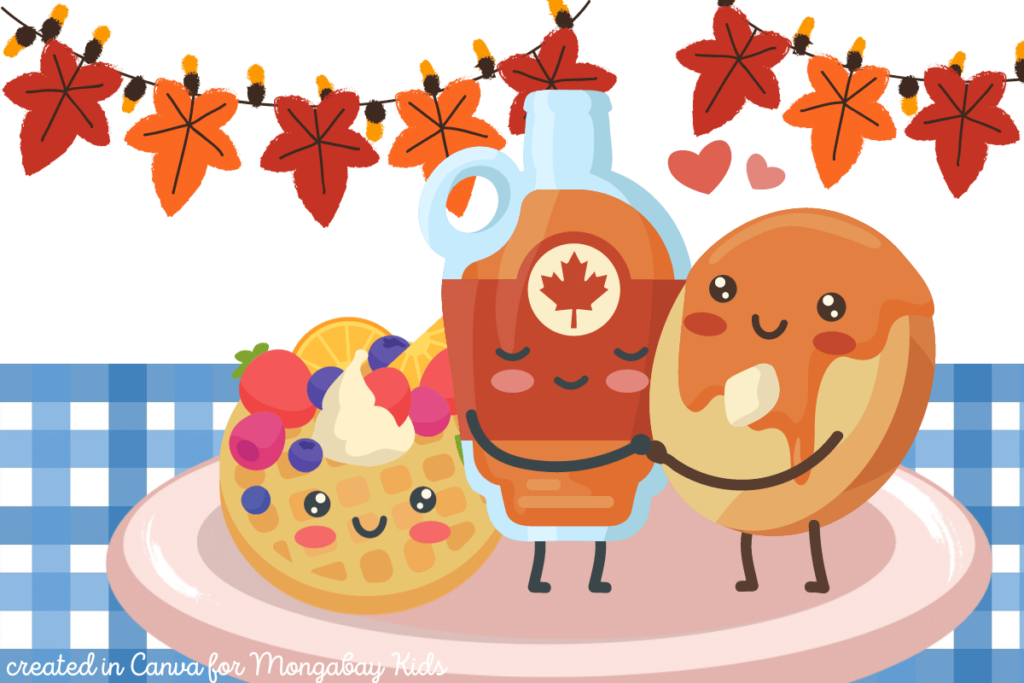
Where does maple syrup come from?
Have you ever wondered where that delicious, sticky maple syrup on your pancakes and waffles comes from?
It is made from the sap of maple trees. Sap is the fluid within trees that helps move sugars around the tree. To make syrup, humans drill holes in maple trees and drain (tap) the sap. When the sap is boiled, water in the sap evaporates and sweet yummy syrup is left behind.
Most of the maple syrup in the world comes from maple forests in northeastern North America, like this one:

Early winter view of forest understory at Bourdon Maple Farm. The lines of blue tubing shown here connect taps on the trees to tanks that collect the sap. Image by Nina Foster for Mongabay.
Now that you know where your maple syrup comes from, the next question you are probably asking yourself is “Can maple syrup help protect birds and other wildlife in the maple forests where the syrup comes from?”
The answer is yes, at least in some forests in Vermont.
Besides maple trees, these forests are home to many other species, including birds like the wood thrush:

Wood thrush. Image courtesy of Michael Parr / American Bird Conservancy.
Forest birds need diverse habitats with trees of different ages. A combination of young, middle-aged and old growth trees has good feeding and nesting opportunities for birds. Unfortunately, much of the forest in Vermont and other parts of New England is made up of only middle-aged trees. These trees are regrowth from widespread clearing for agriculture in the 1800s.
And forests are still being converted into residential areas, parking lots and other unforested landscapes to meet human needs. This human activity further reduces the amount of habitat available for forest birds and other wildlife.
As a result, many forest bird populations have suffered. Wood thrush populations have been cut in half in 50 years due to forest loss. Forest loss exposes the nests of wood thrushes to predators and parasites. Vermont’s Wildlife Action Plan identifies wood thrushes as a “species of greatest conservation need.”
In Vermont, the Bird-Friendly Maple Project is helping to protect habitat for birds
A stand of maple trees that are tapped for their sap is called a sugarbush. Some maple sugar producers remove most or all of the non-maple trees growing beneath the forest canopy. This limits the forest’s ability to support wildlife and withstand disturbances like climate change. The number and types of birds decrease when 75% or more of a forest is made up of only sugar maple trees.
In Vermont, conservation group Audubon Vermont, the Vermont Maple Sugar Makers’ Association, and the Vermont Department of Forests, Parks and Recreation teamed up to create the Bird-Friendly Maple Project. The program celebrates maple syrup producers who protect forest bird habitats and provides a label that customers can look for when buying syrup.

Bottles of Bourdon Maple Farm syrup bearing the bird friendly logo. Image by Nina Foster for Mongabay.
The label features the scarlet tanager, a species that is helped by the project.

Vermont’s bird friendly maple syrup logo features the scarlet tanager, a species that benefits greatly from the kind of stewardship which the program encourages.
For a maple producer to earn the bird-friendly label, they must commit to a management plan that ensures a future sugarbush composition of no more than 75% sugar maples.
Bird-friendly producers must also improve the structural complexity of their sugarbush. “Structural complexity” means that a forest has a good understory (the first 5 feet above the forest floor, where flowers, ferns and shrubs are likely to grow) and midstory (trees and shrubs standing between 5 and 30 feet in height).
Some birds need saplings and shrubs to nest in. A complex forest provides nesting and feeding opportunities from the ground all the way to the forest canopy.
“A messy forest is a little harder to work in. As a sugar maker, it can be difficult to walk out and tap your trees if you’re working through brambles and snags — but it’s good for the wildlife,” said Aaron Wightman, lifelong maple producer in Vermont.

Scarlet tanager. Photo by Jen Goellnitz via Flickr (CC BY-NC 2.0)
Audubon Vermont studied how forest bird communities respond to habitat changes in actively managed sugarbushes. They found that diverse vegetation and structure in a sugarbush allows the landscape to better meet the needs of more types of forest birds. For example, mourning warblers, chestnut-sided warblers and black-throated blue warblers do much better in well-managed sugarbushes.
Other states are now using the program too, like New York, Massachusetts and Maine. Thanks to the Bird-Friendly Maple Project, approximately 7,284 hectares (18,000 acres) of forest are managed with birds in mind.
The special label shows maple syrup users that their syrup is good for birds and pancakes too!
David Brown adapted this story for Mongabay Kids. It is based on an article by Nina Foster, published on mongabay.com:






